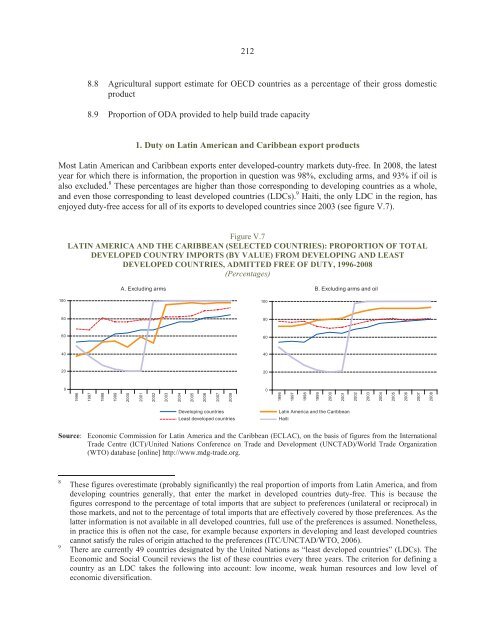sustainable development 20 years on from the ... - José Eli da Veiga
sustainable development 20 years on from the ... - José Eli da Veiga
sustainable development 20 years on from the ... - José Eli da Veiga
Create successful ePaper yourself
Turn your PDF publications into a flip-book with our unique Google optimized e-Paper software.
212<br />
8.8 Agricultural support estimate for OECD countries as a percentage of <strong>the</strong>ir gross domestic<br />
product<br />
8.9 Proporti<strong>on</strong> of ODA provided to help build trade capacity<br />
1. Duty <strong>on</strong> Latin American and Caribbean export products<br />
Most Latin American and Caribbean exports enter developed-country markets duty-free. In <str<strong>on</strong>g>20</str<strong>on</strong>g>08, <strong>the</strong> latest<br />
year for which <strong>the</strong>re is informati<strong>on</strong>, <strong>the</strong> proporti<strong>on</strong> in questi<strong>on</strong> was 98%, excluding arms, and 93% if oil is<br />
also excluded. 8 These percentages are higher than those corresp<strong>on</strong>ding to developing countries as a whole,<br />
and even those corresp<strong>on</strong>ding to least developed countries (LDCs). 9 Haiti, <strong>the</strong> <strong>on</strong>ly LDC in <strong>the</strong> regi<strong>on</strong>, has<br />
enjoyed duty-free access for all of its exports to developed countries since <str<strong>on</strong>g>20</str<strong>on</strong>g>03 (see figure V.7).<br />
Figure V.7<br />
LATIN AMERICA AND THE CARIBBEAN (SELECTED COUNTRIES): PROPORTION OF TOTAL<br />
DEVELOPED COUNTRY IMPORTS (BY VALUE) FROM DEVELOPING AND LEAST<br />
DEVELOPED COUNTRIES, ADMITTED FREE OF DUTY, 1996-<str<strong>on</strong>g>20</str<strong>on</strong>g>08<br />
(Percentages)<br />
A. Excluding arms B. Excluding arms and oil<br />
100<br />
100<br />
80<br />
80<br />
60<br />
60<br />
40<br />
40<br />
<str<strong>on</strong>g>20</str<strong>on</strong>g><br />
<str<strong>on</strong>g>20</str<strong>on</strong>g><br />
0<br />
0<br />
1996<br />
1997<br />
1998<br />
1999<br />
<str<strong>on</strong>g>20</str<strong>on</strong>g>00<br />
<str<strong>on</strong>g>20</str<strong>on</strong>g>01<br />
<str<strong>on</strong>g>20</str<strong>on</strong>g>02<br />
<str<strong>on</strong>g>20</str<strong>on</strong>g>03<br />
<str<strong>on</strong>g>20</str<strong>on</strong>g>04<br />
<str<strong>on</strong>g>20</str<strong>on</strong>g>05<br />
<str<strong>on</strong>g>20</str<strong>on</strong>g>06<br />
<str<strong>on</strong>g>20</str<strong>on</strong>g>07<br />
<str<strong>on</strong>g>20</str<strong>on</strong>g>08<br />
1996<br />
1997<br />
1998<br />
1999<br />
<str<strong>on</strong>g>20</str<strong>on</strong>g>00<br />
<str<strong>on</strong>g>20</str<strong>on</strong>g>01<br />
<str<strong>on</strong>g>20</str<strong>on</strong>g>02<br />
<str<strong>on</strong>g>20</str<strong>on</strong>g>03<br />
<str<strong>on</strong>g>20</str<strong>on</strong>g>04<br />
<str<strong>on</strong>g>20</str<strong>on</strong>g>05<br />
<str<strong>on</strong>g>20</str<strong>on</strong>g>06<br />
<str<strong>on</strong>g>20</str<strong>on</strong>g>07<br />
<str<strong>on</strong>g>20</str<strong>on</strong>g>08<br />
Developing countries<br />
Least developed countries<br />
Latin America and <strong>the</strong> Caribbean<br />
Haiti<br />
Source: Ec<strong>on</strong>omic Commissi<strong>on</strong> for Latin America and <strong>the</strong> Caribbean (ECLAC), <strong>on</strong> <strong>the</strong> basis of figures <strong>from</strong> <strong>the</strong> Internati<strong>on</strong>al<br />
Trade Centre (ICT)/United Nati<strong>on</strong>s C<strong>on</strong>ference <strong>on</strong> Trade and Development (UNCTAD)/World Trade Organizati<strong>on</strong><br />
(WTO) <strong>da</strong>tabase [<strong>on</strong>line] http://www.mdg-trade.org.<br />
8<br />
9<br />
These figures overestimate (probably significantly) <strong>the</strong> real proporti<strong>on</strong> of imports <strong>from</strong> Latin America, and <strong>from</strong><br />
developing countries generally, that enter <strong>the</strong> market in developed countries duty-free. This is because <strong>the</strong><br />
figures corresp<strong>on</strong>d to <strong>the</strong> percentage of total imports that are subject to preferences (unilateral or reciprocal) in<br />
those markets, and not to <strong>the</strong> percentage of total imports that are effectively covered by those preferences. As <strong>the</strong><br />
latter informati<strong>on</strong> is not available in all developed countries, full use of <strong>the</strong> preferences is assumed. N<strong>on</strong>e<strong>the</strong>less,<br />
in practice this is often not <strong>the</strong> case, for example because exporters in developing and least developed countries<br />
cannot satisfy <strong>the</strong> rules of origin attached to <strong>the</strong> preferences (ITC/UNCTAD/WTO, <str<strong>on</strong>g>20</str<strong>on</strong>g>06).<br />
There are currently 49 countries designated by <strong>the</strong> United Nati<strong>on</strong>s as “least developed countries” (LDCs). The<br />
Ec<strong>on</strong>omic and Social Council reviews <strong>the</strong> list of <strong>the</strong>se countries every three <str<strong>on</strong>g>years</str<strong>on</strong>g>. The criteri<strong>on</strong> for defining a<br />
country as an LDC takes <strong>the</strong> following into account: low income, weak human resources and low level of<br />
ec<strong>on</strong>omic diversificati<strong>on</strong>.













